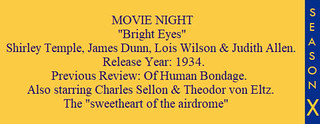
Review #1351: The Rains Came.
Cast:
Myrna Loy (Lady Edwina Esketh), Tyrone Power (Major Rama Safti), George Brent (Tom Ransome), Brenda Joyce (Fern Simon), Nigel Bruce (Lord Albert Esketh), Maria Ouspenskaya (Maharani), Joseph Schildkraut (Mr. Bannerjee), Mary Nash (Miss MacDaid), Jane Darwell (Aunt Phoebe - Mrs. Smiley), Marjorie Rambeau (Mrs. Simon), and Henry Travers (Rev. Homer Smiley) Directed by Clarence Brown (#423 - A Woman of Affairs, #433 - Angels in the Outfield, and #484 - Plymouth Adventure)
Review:
If you want a disaster film to go along with your romance, I guess this could fit the bill. This was a film that 20th Century Fox spent nearly half of its 100-day schedule in making rain to go along with a flood sequence (using a 50,000 gallon tank of water on a studio soundstage), with 33 million gallons of water used, with a fifth of the $2.5 million budget being spent on flood and earthquake scenes. It surely paid off for its effects crew, since E. H. Hansen and Fred Sersen ended up as the first awardees for Best Visual Effects through this film. Who better to helm the film than veteran director Clarence Brown (a versatile director of romance, dramas and period pieces) and established actors like Loy (a versatile actress known for vamp roles prior to The Thin Man in 1934), Power (a matinee idol in the latter 1930s along with the 1940s), and Brent (a leading man for romances primarily in the 1930s and 1940s) to go with it. The film was adapted to the screen by Philip Dunne and Julien Josephson from the 1937 novel of the same name by Louis Bromfield. A remake would be produced by the studio with The Rains of Ranchipur (1955), which changed the ending (so no one dies). This is a glossy but finely crafted film, where one will be pleased at what they get on a visual level alongside the romantic quartet when it comes to generating intrigue. Loy certainly seems to be having fun with such a mischievous (at least at first mischievous) headline role, brash but immensely watchable every time she is on screen, whether that involves playful banter or helping the sick. Power comes off a bit reserved, but it works out in making calm passion. This plays itself out with Loy's death scene, where Brown had told her to try acting it out with her eyes open through holding her breath. It is a striking scene, one must say. Brent plays a decent rogue, one that fits in contrast to whoever leading lady he is playing towards, whether that means a clash with Loy or a fresh (in that this was her debut role) Joyce. Bruce (a character actor since 1922 whose most famous portrayal was of Dr. Watson starting in 1939) certainly does fine with a boorish turn, and Ouspenskaya certainly proves a charmer from time to time. The romances play out fine for its 105 minute run-time, where one can see how they'll draw themselves out but not find themselves predicting everything (for a film with a title like this, at least). In a year with plenty of romance and spectacle on numerous fronts, The Rains Came is a decent little gem among others. It makes for a decent show with its fair passion and well-done effects to make a diverting time to go with, utilizing a workable cast and an accomplished director to get things done without too many troubles.
Overall, I give it 7 out of 10 stars.
Ah yes, the end of the month (and the tribute to the 1930s) has come. If you are wondering, I have not forgotten about doing films from the current year as well. Those will be sprinkled into March at their own time, apart from the primary goal of March, the third phase of Tribute to the Decades with the 1940s.





 Review
Review  Review
Review  Review #1345: Pigskin Parade.
Review #1345: Pigskin Parade.




 Review #1339: Cavalcade.
Review #1339: Cavalcade. Review #1338: Grand Hotel.
Review #1338: Grand Hotel.

 Review #1335: Tabu: A Story of the South Seas.
Review #1335: Tabu: A Story of the South Seas.